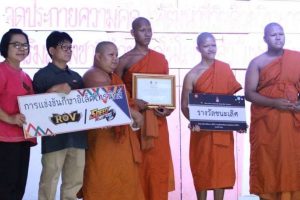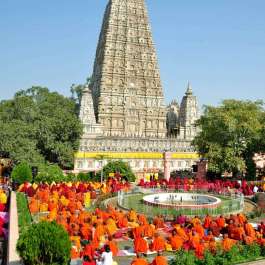Beginner’s Mind is a special project from BDG collecting insightful essays written by US college students who have attended experiential-learning courses related to Buddhism. Some of the authors identify as Buddhists, for others it is their first encounter with the Buddhadharma. All are sharing reflections and impressions on what they’ve learned, how it has impacted their lives, and how they might continue to engage with the teaching.
Aisha Shams wrote this essay for her Brutal Buddhism course at Trinity College in Hartford, Connecticut. A prospective psychology major, Aisha also likes to spend her free time watching BBC Earth and exploring contemporary poetry.

Part of the Ocean: On Buddhism and Islam
I consider myself religious, although that is not to say that I am regularly practicing. In fact, I do allow myself the liberty of interpreting certain rules and beliefs as I wish. This is because I have grown up with the understanding that religion is deeply personal. Both of my parents are Muslims, but the Islam they know and believe in is vastly different. My mother has influenced me the most, in terms of approaching, questioning, and thinking about religion and what it means to me. Because she has given me the resources and agency to challenge the “divinely ordained” beliefs, I have learned to look at religion as not something that is imposed or blindly followed, but as a truth that I am slowly uncovering, little by little. Religion has taught me gratitude. It grounds me. In the worst of times, religion gives me resilience.
When I saw this course, the title, Brutal Buddhism, instantly piqued my interest because “brutal” is a word not commonly associated with Buddhism. The popular and orientalist understanding of Buddhism is muted, presenting Buddhism as an inherently peaceful religion that, if followed, renders one incapable of violence or inflicting harm. In this way, Buddhism seems almost detached from the real world of imperfections and people who are susceptible to violence and prejudice. Buddhism is sometimes glorified to the extent that people often find it uncharacteristic of Buddhists when they commit murder or genocide, forgetting that they, too, are humans who experience feelings of rage, contempt, and exclusion.
In this regard, I found Edward Said’s Orientalism, Satish Kumar’s Buddha and the Terrorist, and Thomas Tweed’s article on “Why Are Buddhists So Nice?” most rewarding and informative.
In Kumar’s book, there is a conversation between Ańgulimāla and a woman giving birth. The latter is consoled by Ańgulimāla, who encourages her to accept and embrace the essence of pain: “Pain is part of life. By accepting it, its intensity is reduced. Do not resist it.” (Kumar 111) That fact that pain is natural and temporary, that it is not an insurmountable phenomenon, is a detail we tend to forget and, at times, consciously reject. This reminder of pain being transient is simple but a beautiful core truth about life.
I found several intersections between Islam and Buddhism during this course, and one such juncture is the idea of non-attachment. Islam encourages people to be humble and to turn away from material wealth. Similarly, Buddhism teaches the idea of non-self and that it is imperative to “empty yourself of ambitions, likes and dislikes.” (Kumar 72) Attachment is clinging and being tied to an idea or place. It implies possessiveness and having a sense of ownership, the existence of “mine” and “yours,” giving rise to the three poisons.
In both Buddhism and Islam, it is important to recognize the impermanent nature of worldly attachments. In Kumar’s book, the Buddha tells Nandini, “Be the wave, and know that you are part of the great ocean of existence.” (Kumar 73) When we are at the sea, or anywhere outside and closer to nature, we feel that we are part of something bigger than ourselves. It is massive and hauntingly beautiful. In such moments, we are simultaneously humbled and gratified: we know there is a reason why we are still here.
There is more than one Buddhism, just as there are multiple “versions” of Islam, Christianity, and Hinduism. Faith, in my opinion, is reconstructed each time we give ourself a moment to acknowledge a form of higher power. Instead of viewing it as a discrete set of symbols and meanings, religion has to be understood in the context of the culture within which it exists—and most importantly, the individual who believes. A. Helwa notes in her book Secrets of Divine Love: “Awakening to faith is not a one-time event, but a continuously unfolding reality.” (Helwa XXI)
With every ritual, inferred belief, and legend that I encounter, I am a step closer to the absolute and divine truth that is present in all religions: love.
References
Said, Edward W. 1979. Orientalism. New York City: Vintage Books.
Kumar, Satish. 2006. The Buddha and the Terrorist. New York City: Algonquin Books.
Tweed, Thomas. “Why Are Buddhists So Nice? Media Representations of Buddhism and Islam in the United States Since 1945.” ResearchGate, March 2008. https://www.researchgate.net/publication/250172309_Why_Are_Buddhists_So_Nice_Media_Representations_of_Buddhism_and_Islam_in_the_United_States_Since_1945
Helwa, A. 2020. Secrets of Divine Love: A Spiritual Journey into the Heart of Islam. New York: Naulit Publishing House.
Related features from BDG
Beyond the Stereotype: Challenging the Perception of a Peaceful Religion
A Tree Grows in Hartford
Brutal Buddhism – Looking for Meaning and Connection in a Fragmented World











